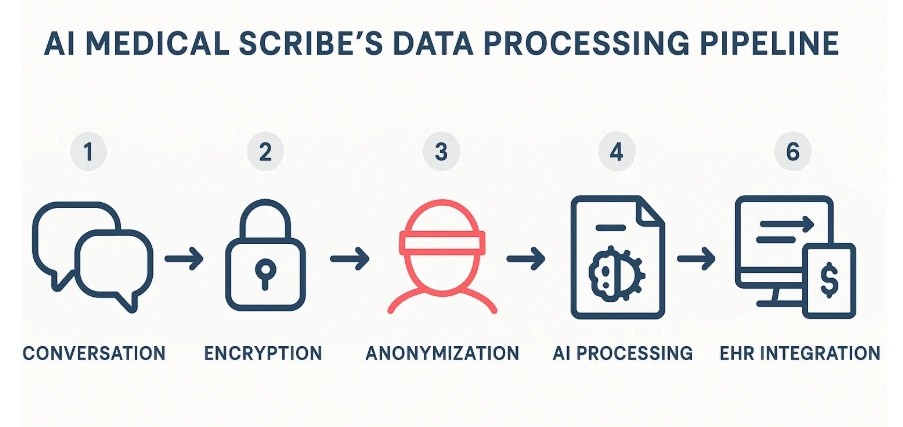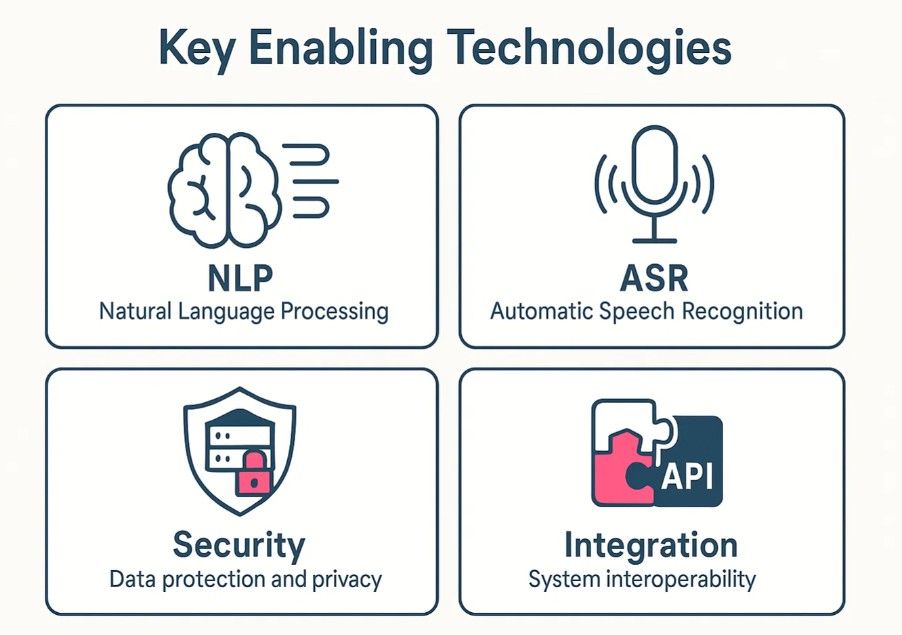
Executive Summary: Reclaiming Time for Patient Care
The healthcare industry faces a critical challenge with physician burnout, driven largely by overwhelming administrative duties. This is not a minor inconvenience but a systemic crisis affecting patient care quality. It also costs the U.S. healthcare system an estimated $4.6 billion annually from physician turnover. An AI Medical Scribe emerges as a powerful solution. It automates clinical documentation from patient-doctor conversations. This allows clinicians to focus entirely on the patient, not the keyboard.
A truly transformative AI medical scribe solution must address unique clinical realities. This includes understanding mixed-language conversations and specializing in niche medical fields. It also means guaranteeing data security through custom architecture. This page explains how to build such a bespoke AI Medical Scribe.
1. The Challenge: The Crushing Weight of Clinical Documentation

Context: The Modern Clinician’s Administrative Burden
Physician burnout is a pervasive, organizational-level problem. Recent studies show a significant percentage of physicians report at least one symptom of burnout. A primary source of this stress is the volume of administrative tasks. In fact, over 12% of physicians cite “too many administrative tasks” as a key driver of job stress.
This data reveals a direct link between clerical workload and burnout. The problem originates not from a lack of physician resilience but from the inefficient systems in which clinicians must work. The hours spent on documentation represent the epicenter of this crisis. An effective solution must address the system itself.
Key Pain Points Addressed by an AI Medical Scribe
- Physician Burnout and “Pajama Time”: Clinicians often spend hours after work catching up on charts. This leads to profound exhaustion and severely diminishes work-life balance.
- Divided Attention During Consults: Doctors experience significant cognitive strain from multitasking. They must listen to a patient, think clinically, and type into an EHR simultaneously. This constant division of focus degrades the quality of human interaction.
- “Click Fatigue” and Inefficient Workflows: Clinicians waste valuable time navigating clunky EHR interfaces. They manually enter data and look up billing codes. This process creates immense frustration and inefficiency.
- Anxiety Over Recall Accuracy: The mental burden of trying to perfectly remember conversational details hours later is substantial. This creates anxiety about potential documentation errors and omissions.
Limitations of Traditional Approaches
Traditional documentation methods are not just inefficient; they are fundamentally flawed for a modern clinical setting. Human scribes, while an improvement over manual entry, introduce their own challenges of high cost, frequent turnover, and limited scalability, making them an unsustainable solution for many practices. A custom AI-powered approach overcomes these inherent limitations.
| Feature/Challenge | Traditional Methods (Manual Entry / Human Scribe) | Custom AI Medical Scribe Solution |
|---|---|---|
| Documentation Time | Involves hours of post-consultation work (“pajama time”). | Generates an instant draft note immediately after the consultation. |
| Patient Interaction | Divides the clinician’s focus between the patient and the computer screen. | Enables 100% focus on the patient, which improves rapport and care quality. |
| Accuracy & Consistency | Is prone to human error, fatigue, and memory lapses, leading to inconsistent note quality. | Captures the conversation verbatim, ensuring high factual accuracy and consistency. |
| Cost & Scalability | Entails high costs and turnover for human scribes; represents an inefficient use of physician time. | Offers a scalable model with a lower operational cost over time compared to human scribes. |
| Data Security | Relies on human discretion and general network security protocols. | Is architected for maximum security with end-to-end encryption and on-premise control. |
| Specialized Knowledge | Requires extensive and costly training for human scribes in each medical specialty. | Fine-tunes AI models for deep expertise in specific domains like Pediatrics or Dermatology. |
| Complex Language | Poses challenges for human scribes who may struggle with regional accents or mixed languages. | Can be specifically trained to understand regional accents and code-mixing (e.g., ‘Hinglish’). |
2. The AI Solution Concept: A Bespoke AI Medical Scribe System
This section outlines the vision for a custom solution, reflecting a healthcare organization’s complex requirements. The central vision is to create an intelligent clinical assistant that operates invisibly in the background.
This assistant eliminates the administrative burden of documentation while enhancing data security and clinical efficiency. The objectives for this AI medical scribe system are clear and targeted.
Vision & Objectives for an AI-Powered System
- Achieve Complete Data Sovereignty: Architect the system for optional on-premise deployment. This ensures all patient data is processed and stored exclusively on servers within the client’s jurisdiction. This approach provides absolute control and guarantees data residency.
- Develop Deep Clinical Expertise: Fine-tune the AI models to achieve an expert-level understanding of unique terminology. This includes the specific abbreviations and documentation styles of fields like Pediatrics and Dermatology.
- Ensure Flawless Real-World Accuracy: Engineer the system to accurately transcribe and understand complex conversations. It must master code-mixed languages like ‘Hinglish’ (Hindi-English) and a wide range of global accents without error.
- Enable Seamless Workflow Integration: Build a simple, one-click mechanism for secure data transmission directly into the organization’s existing Electronic Health Record (EHR) system.
- Deliver Clinician-Centric Features: Provide an instant and highly accurate draft note post-consultation. The system will also automate suggestions for relevant medical billing codes. Finally, it will offer a management dashboard for key operational analytics.
3. How does the AI Medical Scribe Works: The Technology Explained
Data Acquisition: The Doctor’s Simple Workflow
The process begins by capturing the natural conversation between a doctor and a patient. The system design prioritizes flexibility and ease of use for the clinician. An AI Medical Scribe can capture audio from various devices already in the clinical workflow.
These devices include a dedicated app on a smartphone, an ambient microphone, or a web browser for telehealth. The clinician’s interaction is minimal. They simply tap ‘Start Listening’ and ‘Stop Listening’. The technology handles everything else.
The AI Processing Pipeline: From Conversation to Clinical Note

This is where a sophisticated, multi-step process transforms spoken words into a structured clinical document. The journey of an AI Medical Scribe from listening to documenting involves several critical stages.
- Secure Capture and Encryption: First, the moment the clinician initiates the recording, the system applies end-to-end encryption (a method of securing data so only the sender and intended recipient can read it). This action protects the audio stream from the point of capture, ensuring it remains confidential and secure during transit.
- Pre-Processing and Anonymization: Next, the system performs a crucial privacy-enhancing step. Before the main AI model analyzes the content, a preliminary process identifies and strips out all Personally Identifiable Information (PII), such as names and addresses. This “anonymization-first” approach ensures the AI that structures the medical details never processes sensitive personal data.
- High-Fidelity Transcription: The encrypted, anonymized audio then moves to a highly specialized Automatic Speech Recognition (ASR) (technology that converts spoken language into text) engine. This is not a generic transcription tool. It is a model specifically fine-tuned to handle code-mixed languages like ‘Hinglish’, recognize diverse accents, and accurately transcribe complex medical terminology for specific fields.
- Contextual Understanding and Structuring: Once transcribed, the text flows to the Natural Language Processing (NLP) (a field of AI that helps computers understand and interpret human language) core. The system uses advanced NLP models to differentiate between speakers, extract key clinical entities like symptoms and diagnoses, and organize this information into a standard clinical format, such as a SOAP note.
- Automated Billing Code Suggestion: The system then analyzes the structured note, particularly the assessment and plan sections. It cross-references the documented diagnoses and procedures against medical coding databases. This allows it to automatically suggest the correct ICD-10 and CPT codes, which significantly reduces administrative work and helps prevent billing errors.
- Secure Re-identification and Finalization: In the final step, within the secure on-premise environment, the system re-inserts the previously removed PII back into the structured, coded note. The output is a complete, compliant, and accurate document ready for clinician review.
Output & Interaction: The Clinician’s Review and Approval
The system presents the final draft note to the clinician instantly after the consultation. The interface allows for quick review and easy editing, though a specialized AI Medical Scribe minimizes the need for changes.
With a single tap on ‘Approve & Save’, the system securely transmits the note via an API. It files it directly into the patient’s EHR record. This completes the entire documentation workflow before the next patient arrives.
4. Key Tech Stack for AI Medical Scribe
A powerful and compliant AI Medical Scribe relies on the sophisticated integration of several advanced technologies. A generic product might excel in one area but fail to meet the complex, intersecting needs of a specialized healthcare environment. The true solution lies in a carefully architected system that combines these core components.

- Specialized Natural Language Processing (NLP) Models: We develop and fine-tune NLP models on domain-specific data. For example, using anonymized pediatric or dermatological notes ensures the AI understands the context, slang, and abbreviations unique to each field. This deep specialization is critical for generating accurate and relevant clinical documentation.
- Advanced Code-Switching ASR: We build Automatic Speech Recognition (ASR) models using advanced techniques. These models train on curated datasets to handle the fluid, real-time switching between languages like Hindi and English. This is a significant challenge that generic ASR systems consistently fail to meet.
- Secure On-Premise Architecture: We design the entire AI medical scribe system for deployment on a client’s private servers. This architecture provides ultimate control over data. It also ensures compliance with data residency laws and eliminates reliance on third-party cloud providers for processing and storage.
- FHIR-Based API Integration: We use Fast Healthcare Interoperability Resources (FHIR) (a modern standard for exchanging healthcare information electronically) for EHR integration.
The right technologies are foundational. See how Softlabs Group architects powerful, custom AI solutions to solve complex business challenges.
Explore Our AI Development Services5. Potential Impact & Benefits for Healthcare Providers
A custom-built AI scribe solution connects advanced technology directly to tangible, compelling benefits for clinicians and their organizations. It addresses the core pain points of the modern medical practice, creating significant positive impact.

- The End-of-Day Relief: The most significant impact is the elimination of hours of after-hours charting. By generating notes instantly, the AI Medical Scribe gives clinicians back their evenings. This dramatically reduces a primary source of burnout.
- The Freedom to Be Human: By removing the need to type during consultations, the AI scribe allows doctors to maintain eye contact. They can listen with empathy and build stronger patient rapport. This restores the human element to medicine and reduces the mental strain of multitasking.
- Drastic Reduction in “Click Fatigue”: The seamless, one-click EHR integration and automated billing code suggestions eliminate tedious digital workflows. This saves time and reduces clinician frustration, allowing them to focus on higher-value tasks.
- The “Perfect Memory” Assistant: The AI Medical Scribe acts as an infallible record of the consultation. This function ensures notes are factually precise and complete. It reduces the clinician’s anxiety about recall errors and improves the quality and defensibility of the medical record.
- Improved Revenue Cycle Management: With automated, more accurate medical coding, the system helps reduce billing errors. It also decreases claim denials and accelerates the reimbursement cycle. This provides a tangible financial return on investment for the healthcare organization.
The benefits outlined here are not just theoretical. Discover real-world examples of how our bespoke solutions have driven tangible results for our clients.
View Our Case Studies6. Important Considerations for Implementing AI Medical Scribe
Deploying a sophisticated AI system requires careful planning and expert execution. Addressing these practical factors is key to a successful implementation that delivers maximum value.
- Data Strategy and Model Training: A high-performing AI Medical Scribe requires training on relevant data. A key implementation step involves creating a secure strategy. This strategy uses anonymized, specialty-specific data to fine-tune the AI models for maximum accuracy.
- Infrastructure and Deployment: An on-premise solution requires careful planning of the server infrastructure. This planning ensures both performance and security. It includes defining hardware specifications, network configuration, and robust security protocols.
- EHR Integration and Workflow Design: While FHIR APIs simplify the technical connection, successful integration requires more. It demands a deep understanding of the specific EHR system’s API endpoints. It also needs a collaborative effort to design a workflow that is truly seamless for clinicians.
- Change Management and User Adoption: Introducing any new technology requires clear communication and training. A successful rollout plan engages clinicians early. It clearly demonstrates the benefits and provides robust support to ensure smooth adoption across the organization.
- Compliance and Governance: Beyond the technology, implementation requires establishing clear governance policies. These policies must cover patient consent, data handling, and the clinician’s final role in reviewing and validating AI-generated notes to ensure full legal and ethical compliance.
- Ongoing Model Maintenance: AI models are not “set and forget” tools. A plan for continuous monitoring is essential. This includes periodic retraining with new data and regular updates to maintain high performance and adapt to evolving medical language.
7. Tailoring AI for Your Unique Needs with Softlabs Group
The AI Medical Scribe solution described here represents the gold standard for clinical documentation automation. However, achieving this performance is not possible with a generic product. Deep specialty knowledge, flawless multilingual understanding, and absolute data control require a custom approach.
Realizing the full potential of an AI Medical Scribe requires a solution built for your specific challenges, workflows, and security postures. Softlabs Group specializes in AI medical scribe development. We partner with healthcare organizations to understand their unique requirements and build truly bespoke systems.
We architect solutions from the ground up to solve problems that standard software cannot. We turn visionary concepts into powerful, practical, and compliant clinical tools.
Ready to transform your clinical workflows and empower your physicians? Let’s discuss how a bespoke AI Medical Scribe can be tailored to your organization’s unique needs.
Discuss Your Custom AI Project With Us